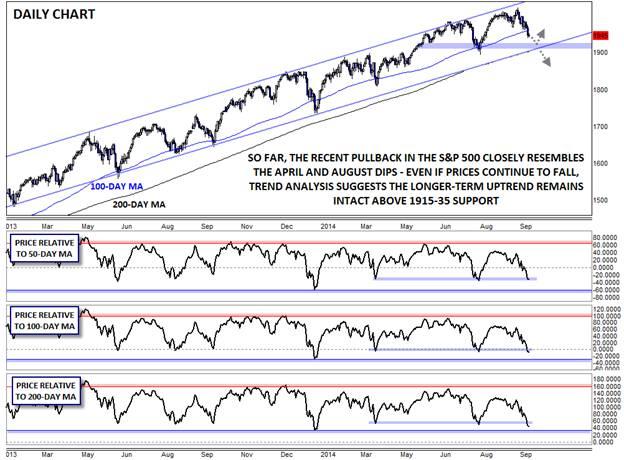![]()
As my colleague Fawad Razaqzada noted earlier today, the FTSE and other European stock indices are stabilizing today after yesterday’s collapse on the back of weak US Manufacturing data and profit-taking ahead of high-impact economic data. US markets also started the month of October off on the wrong foot, with the Dow Jones Industrial Average falling 238 points yesterday, while the S&P 500 shed 26 points.
After yesterday’s harrowing drop global stock markets, traders the world over are wondering whether the long-awaited correction is underway. Rather than making rash emotional decisions, we wanted to look take an objective look at the health of the prolonged uptrend off the 2011 low.
In a sideways market, technical traders often look at the price relative to static support or resistance areas to determine whether the instrument is breaking out. This same principle can be adapted to evaluate whether a longer-term trend is breaking by looking at the price relative to a dynamic level of support or resistance, like a moving average.
Readers can easily modify the widely used Moving Average Convergence-Divergence (MACD) indicator to display this information by changing the settings for the first period to 1 and the second period to their preferred MA length (ignore the signal line). These parameters tell the trading software to calculate the difference between the “1-period moving average†(the current price) and the XX-period moving average. When this difference breaks out of an established range, it can be a warning sign that the established trend may be coming to an end.
Below, we apply this tool to the S&P 500 by comparing the current price to the 50-, 100-, and 200-day moving averages. Taking the first indicator pane (“Price Relative to 50-day MAâ€), we can see that the widely-followed US index remains well within its recent range relative the 50-day moving average. In fact, the last pullback in early August took the market about 35 points below its 50-day MA, relative to the current 25 points below. The other panes show a similar picture, with the index a few points below its 100-day MA and still about 50 points above its 200-day MA, in-line with the previous two pullbacks this year.
The upshot of this analysis is that, so far, the recent pullback closely resembles the dips that we saw in April and August. If the S&P 500 finds support and starts to rally into the close of this week, this analysis suggests that the current level may represent a favorable level to join the established uptrend.
Even if prices do continue to fall from here, the longer-term bullish trend will remain intact as long as the three relative MAs remain above their February lows. In this case, those levels are about 60 points below the 50-day MA, 30 points below the 100-day MA, and 35 points above the 200-day MA. In other words, only a drop below strong support in the 1915-1935 zone would suggest that the “character†of the established uptrend has changed.
Until then, the bullish trend remains a friend to US equities.
This research is for informational purposes and should not be construed as personal advice. Trading any financial market involves risk. Trading on leverage involves risk of losses greater than deposits.
Recommended Content
Editors’ Picks
EUR/USD edges lower toward 1.0700 post-US PCE

EUR/USD stays under modest bearish pressure but manages to hold above 1.0700 in the American session on Friday. The US Dollar (USD) gathers strength against its rivals after the stronger-than-forecast PCE inflation data, not allowing the pair to gain traction.
GBP/USD retreats to 1.2500 on renewed USD strength

GBP/USD lost its traction and turned negative on the day near 1.2500. Following the stronger-than-expected PCE inflation readings from the US, the USD stays resilient and makes it difficult for the pair to gather recovery momentum.
Gold struggles to hold above $2,350 following US inflation

Gold turned south and declined toward $2,340, erasing a large portion of its daily gains, as the USD benefited from PCE inflation data. The benchmark 10-year US yield, however, stays in negative territory and helps XAU/USD limit its losses.
Bitcoin Weekly Forecast: BTC’s next breakout could propel it to $80,000 Premium

Bitcoin’s recent price consolidation could be nearing its end as technical indicators and on-chain metrics suggest a potential upward breakout. However, this move would not be straightforward and could punish impatient investors.
Week ahead – Hawkish risk as Fed and NFP on tap, Eurozone data eyed too

Fed meets on Wednesday as US inflation stays elevated. Will Friday’s jobs report bring relief or more angst for the markets? Eurozone flash GDP and CPI numbers in focus for the Euro.
